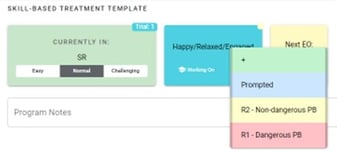Use our pre-built program for Skill-Based Treatment data-collection.
For more information on the SBT algorithm and how it works in Hi Rasmus check out our WHITE PAPER on SBT
Setting up the program
- Go library
- Select
 (upper right hand corner)
(upper right hand corner) - Find Skill-Based Treatment or click here: Skill-Based Treatment template page
- Click Add To Client...
- Select the client you want to add the SBT program to
- The template (program, session, prompt-level template and workflow) will be installed to your client
Running an SBT session
To run an SBT session just go to the client's profile and click Start Session on the SBT Session. You can also add the Skill-Based Treatment to an existing session instead of using the separate session.
SR
While you are in SR the only target you have to address is Happy/Relaxed/Engaged. Click the target to record whether the HRE was achieved without problem behavior (record a +), if there was a prompt used (record prompted), or record an R1 or R2 if problem behavior was observed before HRE was achieved.

Once you take your data, it will automatically move to EO. Initially you will only see sFCR but later in the article we will explain how to progress to cFCR, TR and the CABs.
EO
In EO you record responses by clicking on the target (sFCR). Record a + if the child successfully completed the step, prompted if prompting was needed, and R1 or R2 if problem behavior occurred at this step. Data can only be recorded once per step per trial so use the Undo button if you need to change recorded data.
Once you finish the EO click Continue to SR to return to that state and repeat as needed.

Challenge-level
You can switch between Easy, Normal and Challenging mode throughout the session. In Easy mode the app will tend to lean towards the earlier CABs and less often the maximum CAB. And opposite in Challenging mode where it will prefer later later CABs. Only CABs that the client is currently Working On will be selected.
Progressing through cFCR, TR and the CABs
You can edit the Skill-Based Treatment program for the client to progress to the later stages. The Skill-Based Treatment template uses a few different types of targets.
Transition from sFCR to cFCR
The FCR is set up as a Shaping target. This means that the therapist will only see the current shape of the target during data-collection. When the client is ready to proceed to cFCR you just set the sFCR target to Closed and the cFCR target to Working On:

If the client will not use the cFCR you can just leave that Waiting and progress by opening the TR target.
Progressing to TR
To progress to Tolerance Response simply change the TR target from Waiting to Working On. Leave the Happy/Relaxed/Engaged and FCR targets in Working On.

Likewise when you start working on the CAB1 you just change that target from Waiting to Working On.
Progressing into a CAB Branch
Once you are ready to work on targets within a CAB Branch you just click Edit Branch CABs on the CAB Branch and change the first target to Working on. And the same as you progress. Except for the sFCR you don't have to close earlier targets as the client progresses through the SBT program. The earlier targets will still be selected for some trials.
You can have multiple CAB Branches open at the same time and the App will randomly select between the branches.
Adding new CAB Branches
To add a third CAB Branch we recommend that you just duplicate one of the existing CAB Branches by clicking ... next on the right side of the CAB branch target:


